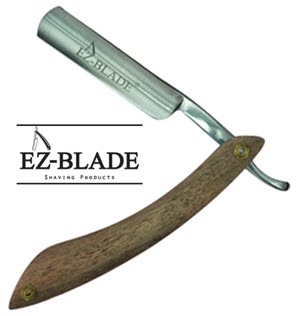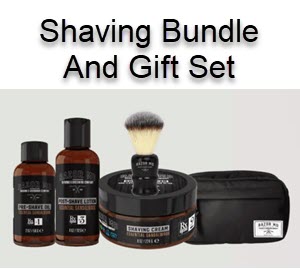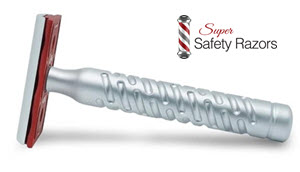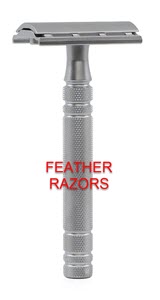Best Razor Strop: Maintaining Your Straight Razor’s Sharpness
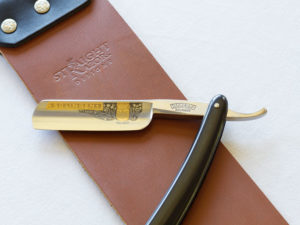 A Brief History of Straight Razors and Their Resurgence
A Brief History of Straight Razors and Their Resurgence
Straight razors, known for their traditional charm and superior control, have a rich history that dates back to the ancient civilizations of Rome and Egypt. For centuries, these razors were the primary tools for men’s grooming. However, the advent of safety razors and disposable blades in the 20th century led to a decline in popularity, mainly due to the convenience and ease of use offered by these newer shaving instruments.
In recent years, there has been a significant resurgence in the use of straight razors. It is attributed to a growing appreciation for traditional grooming practices and pursuit of a more sustainable and cost-effective shaving routine. By returning to the straight razor, individuals can reduce plastic waste from disposable blades and enjoy the satisfaction of mastering a centuries-old skill.
The Importance of a Razor Strop in Maintaining a Straight Razor
Its sharpness is the key to a close, comfortable shave with a straight razor. It is where the razor strop comes into play. A razor strop, typically made from leather or canvas, is an essential tool for maintaining the edge of a straight razor. It aligns the microscopic teeth of the blade’s edge, which get misaligned after a shave, restoring the razor’s sharpness without removing any steel, unlike honing. Regular stropping can extend the life of your straight razor and ensure a consistently smooth shave.
The Relevance of This Article
This article aims to guide sharp razor enthusiasts, novice and experienced, on razor strops. It offers insights into the importance of a razor strop, how to choose the right one, and how to use it to maintain your straight razor’s sharpness. We also provide tips on care and maintenance for your razor strop and troubleshooting common issues. By the end of this article, you’ll have gained the necessary knowledge to maximize your straight razor’s performance and longevity through proper stropping techniques.
Stay tuned, and let’s dive deeper into the world of razor strops!
What is a Razor Strop?
A razor strop is a device to refine and maintain a straight razor’s edge. It’s an essential tool that allows for the straightening (aligning) of the blade’s edge without removing material from the blade. The strop doesn’t sharpen the blade traditionally; instead, it realigns the microscopic teeth of the blade’s edge, which can become misaligned after shaving.
A Brief History and Evolution of Razor Strops
The use of razor strops is as old as the use of straight razors themselves. The need to maintain the sharpness of a blade led to the creation of the first razor strops, which were initially simple strips of leather. Over time, these evolved into the more recognizable form of a strip of leather affixed to a handle for easy manipulation.
In the 19th century, barbers typically used large hanging straps attached to the barber’s chair. As the practice of home shaving grew, smaller and more practical designs of strops became popular, leading to the paddle strop’s development, which had a firm backing, making it easier to maintain the correct tension.
Different Types of Razor Strops: Leather, Canvas, and More
Several razor strops are available today, each offering other qualities and results. The most common styles include:
- Leather Strops: These are the most traditional type of strop and are usually made from cowhide, horsehide, or shell cordovan leather. The leather’s texture and draw (the resistance felt when dragging the blade across the surface) can vary depending on the type and treatment used. Cowhide strops are generally more accessible and offer a good balance of smoothness and draw, making them suitable for beginners and experienced users.
- Canvas Strops: Also known as linen or fabric straps, these are usually used as a preliminary step before stropping on leather. The canvas material helps clean the blade and slightly sharpens the edge. Some users prefer canvas strops for their increased draw compared to leather.
- Balsa Wood Strops: These strops, made of soft, absorbent balsa wood, are often used with honing compounds to create a very sharp edge. They’re typically used as a final step in a multi-stage stropping process.
Choosing the right strop depends on your needs, preferences, and experience level, so understanding each type’s benefits and drawbacks is crucial. In the next section, we’ll look deeper into how to select the perfect strop for your straight razor maintenance.
 Why is a Razor Strop Essential for Your Straight Razor?
Why is a Razor Strop Essential for Your Straight Razor?
The Science of Sharpening: A Microscopic View of a Blade’s Edge
At the microscopic level, the edge of a straight razor blade isn’t a smooth line but a series of tiny serrations or ‘teeth.’ When you shave, these teeth can become misaligned, causing the blade to feel dull. It doesn’t mean the blade is no longer sharp; instead, the edge needs realignment to bring the teeth back into alignment for an optimal shave.
The Role of a Razor Strop in Maintaining Sharpness
It is where a razor strop plays an indispensable role. Stropping aligns the tiny teeth along the blade’s edge, restoring its sharpness and ensuring a close and comfortable shave. The strop’s smooth surface gently straightens the edge without removing any metal from the blade, unlike honing stones that grind away metal to create a new edge.
Stropping your straight razor before each use can significantly improve the quality of your shave. It keeps the blade sharp and extends the intervals between honing sessions.
Long-Term Cost-Effectiveness of Using a Razor Strop
From a financial perspective, investing in a good quality razor strop and learning to use it correctly can save you money in the long run. A well-maintained straight razor can last a lifetime, minimizing the need for replacements or professional sharpening services.
Not only does a strop maintain your razor’s performance, but it also prolongs the blade’s life. Keeping the edge aligned reduces the need for honing, which removes metal from the blade. This slower rate of wear can add years, or even decades, to the lifespan of your razor.
In summary, a razor strop is not just an accessory but a necessary tool for anyone looking to get the most out of their straight razor. Whether you’re an experienced straight razor user or a novice, a quality strop is a worthy investment for maintaining your blade’s performance and extending its life.
Choosing the Right Razor Strop
Choosing the right razor strop is crucial for maintaining your straight razor and enhancing your shaving experience. Here are some key factors to consider when making your selection:
Key Factors to Consider
- Material: Razor strops are made from leather, canvas, and balsa wood. Leather straps are the most traditional and widely used. The type of leather used can affect the strop’s performance, with options like cowhide, horsehide, or the more premium shell cordovan. Canvas or linen strops are often used as a pre-stropping step to clean the blade before moving to the leather strop.
- Size: The size of the strop is another critical factor. Opt for a strop as wide as your razor (about 2 to 3 inches) to hone the entire blade length.
- Price: Strops come in a wide range of prices. While higher-priced strops usually offer better quality and longevity, many affordable strops provide excellent performance for their price.
- User Reviews: Reviews from other users can provide valuable insights into the strop’s quality, durability, and performance.
- Brand Reputation: Brands with a reputation for high-quality shaving accessories will likely offer better-quality strops.
Pros and Cons of Different Types of Razor Strops
Leather Strops:
- Pros: Ideal for final-stage stropping; offers a smooth, low-resistance surface; can last a long with proper care.
- Cons: It can be expensive, particularly premium leather types like shell cordovan, requiring regular maintenance and conditioning.
Canvas Strops:
- Pros: Great for preliminary stropping and cleaning the blade; generally more affordable than leather straps.
- Cons: Can’t provide the final finish a leather strop can; less durable compared to leather.
Balsa Wood Strops:
- Pros: Excellent when used with honing compounds; can provide a very sharp edge.
- Cons: Leather is more traditional and satisfying; it requires regular application of honing compounds.
Recommendations for Beginners, Intermediate, and Advanced Users
- Beginners: A good-quality cowhide leather strap would be an ideal choice. It offers a good balance of smoothness and draw and is generally more forgiving to novice mistakes.
- Intermediate Users: At this stage, you should explore a two-sided strop that features leather on one side and canvas on the other. The canvas side is excellent for pre-stropping to clean the blade before final stropping on the leather side.
- Advanced Users: For seasoned straight razor users, premium options like shell cordovan leather strops or a balsa wood strop for use with honing compounds can take your stropping routine to the next level.
By considering these factors and understanding the pros and cons of different strop types, you can make an informed decision and choose a strop that fits your needs, skill level, and budget.
Step-by-Step Guide to Using a Razor Strop
Maintaining the sharpness of your straight razor involves more than just owning a strop—it’s about knowing how to use it correctly. Here’s a step-by-step guide on how to use a razor strop:
Preparation: Clean and Dry Your Straight Razor
Before you begin stropping, ensure your straight razor is clean and dry. Any dirt, moisture, or leftover shaving soap can interfere with stropping and potentially damage your strop. A simple wipe-down with a soft, dry cloth is usually sufficient.
The Correct Method to Hold and Move the Razor on the Strop
- Holding the Strop and Razor: Secure the top end to a sturdy object at about waist level if you use a hanging strop. Hold the bottom end with your non-dominant hand to keep it taut but not overly tight. With your dominant hand, grasp the razor by the tang (the narrow part that connects the blade to the handle).
- Starting Position: Lay the razor flat on the strop at the end closest to you. The razor’s edge should be facing away from you, and the spine should be in contact with the strop.
- Stropping Motion: Push the razor away from you, keeping it flat against the strop, moving it towards the other end. This motion is often compared to “trying to wipe off the shaving cream.”
- Turning the Razor: Once you reach the end of the strop, flip the razor over its spine (like a book) to the other side. The edge should always be trailing to prevent it from cutting into the strop. After flipping, pull the razor towards you to return to the starting position.
- Repetition: Repeat this process 30-60 times (15-30 laps). A ‘lap’ consists of one trip down and back up the strop.
Common Mistakes to Avoid When Stropping
- Too Much Pressure: Remember, you’re aligning the edge, not trying to grind it. Applying too much pressure can round off the edge and damage the strop.
- Improper Blade Position: The blade should be flat on the strop throughout the process. Lifting the spine and only contacting the edge can cause a rolled edge, making the razor dull.
- Fast Stropping: Stropping is not a speed contest. Especially when starting, it’s essential to prioritize correct technique over speed.
Tips and Tricks for Getting the Best Results
- Regular Maintenance: Strop your straight razor before each shaves to maintain its sharpness.
- Use a Light Touch: Let the strop do the work. A light, consistent touch is better than heavy pressure.
- Strop Conditioning: If you’re using a leather strop, condition it periodically to keep the leather supple and effective.
- Practice Makes Perfect: Don’t be discouraged if you don’t get it right immediately. It takes time and practice to perfect the technique.
By following this guide, avoiding common mistakes, and employing these tips, you can effectively maintain your straight razor’s edge for a consistently smooth and close shave.
Care and Maintenance for Your Razor Strop
Just as a straight razor needs regular care and maintenance, so does a razor strop. By keeping your strop in good condition, you can ensure its effectiveness and prolong its life. Here are some tips on how to care for and maintain your razor strop:
When and How to Clean Your Strop
Cleaning your strop can help remove any built-up metal particles from your straight razor and prevent potential damage to the strop’s surface. While there is no fixed timeline for when to clean your strop, a good rule of thumb is to do it whenever you notice a significant build-up of metal shavings or if the strop’s surface starts to feel less smooth than usual.
To clean your strop:
- Use a soft cloth or a brush with soft bristles.
- Gently wipe or brush the surface of the strop, going with the ‘grain’ of the leather, if there is one.
- Avoid using any cleaning chemicals, as these can damage the material.
The Importance of Conditioning Your Leather Strop
Conditioning is vital to keep the leather soft, pliable, and effective if you have a leather strop. Over time, leather can dry out and become brittle, making it less effective for stropping and more susceptible to damage.
To condition your strop, apply a small amount of leather conditioner to the surface, using a soft cloth to rub it in. Choose a conditioner that doesn’t contain silicones or waxes, as these can build up on the strop and affect its performance.
Storing Your Strop to Maximize Its Lifespan
Proper storage of your strop can significantly contribute to its lifespan. Store your strop in a cool, dry place away from direct sunlight and heat, which can dry out and crack the material. If you have a hanging strop, hang it up when not in use to prevent creasing.
If your strop becomes wet, let it dry naturally away from direct heat to prevent cracking or warping. Keeping your strop clean and dry in humid conditions is essential to prevent mold or mildew growth.
By following these guidelines for cleaning, conditioning, and storing your razor strop, you can ensure it stays in top condition and continues to provide adequate service for many years. Remember, a well-maintained strop equals a well-maintained straight razor!
What if Things Go Wrong? Troubleshooting Common Issues
While using a razor strop is typically straightforward, you may encounter issues or unexpected results. Let’s discuss how to troubleshoot some common problems:
Identifying Signs of a Dull Blade
A correctly stropped blade should provide a smooth, comfortable shave. If you’re finding your shaves becoming less comfortable or experiencing pulling or tugging on your hair, these could be signs your blade is dull. Other symptoms could include repeatedly going over the same area for a clean shave or visible nicks and chips on the blade’s edge.
What to Do if Your Strop Isn’t Working as Expected
If you’re not getting the results you expect from your strop, the problem could be in your technique, the condition of your strop, or the state of your razor blade.
- Check Your Technique: Ensure you follow the correct stropping technique detailed in the ‘Step-by-Step Guide to Using a Razor Strop’ section above. Improper technique can lead to ineffective stropping.
- Assess the Condition of Your Strop: If it is dirty, worn out, or improperly maintained, it may not effectively realign your blade’s edge. Regular cleaning and maintenance of your strop are essential.
- Examine Your Blade: More than stropping alone might be needed if your blade is severely dull or damaged. In this case, your blade may need honing or even replacement.
Common User Errors and How to Rectify Them
- Using Excessive Pressure: Applying too much pressure can round the edge of the blade, making it duller. Use a light, consistent touch when stropping.
- Incorrect Blade Angle: If the spine of the razor isn’t in contact with the strop, it can cause an uneven or rounded edge. Always keep the blade flat against the strop.
- Rushing the Stropping Process: Trying to speed through stropping can lead to mistakes and poor results. Take your time to ensure proper technique.
When to Seek Professional Help or Consider a Replacement Strop
If you’ve tried troubleshooting and are still experiencing issues, it may be time to seek professional help. A skilled professional can inspect your strop, razor, and technique to pinpoint problems and provide solutions.
Consider getting a new one if your strop is worn out, excessively damaged, or poor quality. Remember, a high-quality strop is an investment that pays off in practical and comfortable shaves.
Identifying and addressing these potential issues ensures a consistently high-performing straight razor and an enjoyable shaving experience.
In Conclusion
A straight razor shave can be one of the most enjoyable and satisfying rituals, and an essential part of that process is maintaining the razor’s edge with a quality strop. Throughout this guide, we’ve delved into the importance of a razor strop for straight razor users, illustrating how this seemingly simple tool plays a vital role in keeping your blade at its best.
We’ve unpacked the various types of strops, discussed what to consider when purchasing one, and guided you through using and maintaining your strop. Each step is crucial in maximizing your straight razor’s performance and longevity.
However, remember that stropping is a skill; like any skill, it takes practice to master. Take the time to learn proper stropping techniques, and don’t get discouraged by early mistakes. The rewards of a well-stropped razor—smooth, close shaves and a blade that lasts a lifetime are worth investing time and effort.
Finally, shaving is a personal journey, and every shaver has unique insights, tips, and experiences. We invite you to share yours with the community, whether you’re a seasoned straight razor user or a novice just starting on this exciting journey. Together, we can continue to learn, grow, and enjoy the art of straight razor shaving.
Remember, your razor is only as good as the care you put into it. You’ll elevate your shaving experience to a new level with the right strop and proper technique.
- Bakblade 2.0: The Best Back Shaver for Men
- Ball Shaver That Won’t Cut You
- Shaving Gel: What to Know About!
- Henson Shaving: Where Design Meets Durability and Performance
- Caramel Honey Blonde Hair: Elevate Your Look
- Feather Razors: Precision Shaving for Every Skin Type
- Straight Razor Shaving: Unlocking a Closer, Smoother Shave
- Premium Safety Razors: Your Guide to Quality Shave
- Pros & Cons: Shaving Against the Grain Guide
- Maximize Your Shave: Norelco Sensotouch 3d Razor
